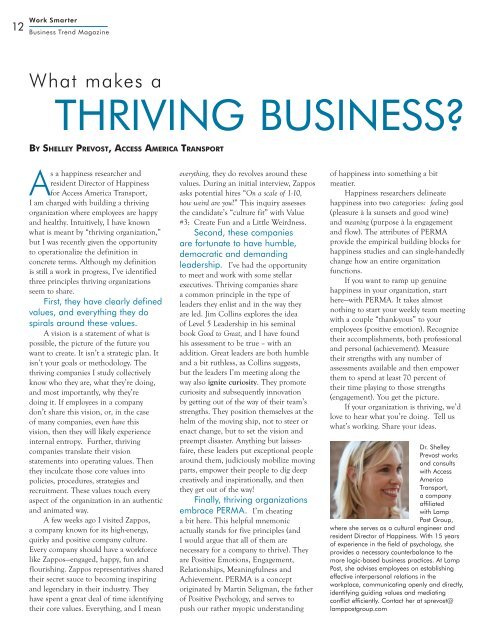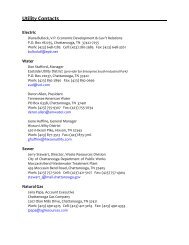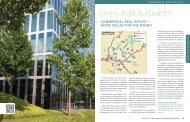Download Full .PDF - Chattanooga Area Chamber of Commerce
Download Full .PDF - Chattanooga Area Chamber of Commerce
Download Full .PDF - Chattanooga Area Chamber of Commerce
- No tags were found...
You also want an ePaper? Increase the reach of your titles
YUMPU automatically turns print PDFs into web optimized ePapers that Google loves.
12<br />
Work Smarter<br />
Business Trend Magazine<br />
What makes a<br />
thriving business<br />
By Shelley Prevost, Access America Transport<br />
As a happiness researcher and<br />
resident Director <strong>of</strong> Happiness<br />
for Access America Transport,<br />
I am charged with building a thriving<br />
organization where employees are happy<br />
and healthy. Intuitively, I have known<br />
what is meant by “thriving organization,”<br />
but I was recently given the opportunity<br />
to operationalize the definition in<br />
concrete terms. Although my definition<br />
is still a work in progress, I’ve identified<br />
three principles thriving organizations<br />
seem to share.<br />
First, they have clearly defined<br />
values, and everything they do<br />
spirals around these values.<br />
A vision is a statement <strong>of</strong> what is<br />
possible, the picture <strong>of</strong> the future you<br />
want to create. It isn’t a strategic plan. It<br />
isn’t your goals or methodology. The<br />
thriving companies I study collectively<br />
know who they are, what they’re doing,<br />
and most importantly, why they’re<br />
doing it. If employees in a company<br />
don’t share this vision, or, in the case<br />
<strong>of</strong> many companies, even have this<br />
vision, then they will likely experience<br />
internal entropy. Further, thriving<br />
companies translate their vision<br />
statements into operating values. Then<br />
they inculcate those core values into<br />
policies, procedures, strategies and<br />
recruitment. These values touch every<br />
aspect <strong>of</strong> the organization in an authentic<br />
and animated way.<br />
A few weeks ago I visited Zappos,<br />
a company known for its high-energy,<br />
quirky and positive company culture.<br />
Every company should have a workforce<br />
like Zappos—engaged, happy, fun and<br />
flourishing. Zappos representatives shared<br />
their secret sauce to becoming inspiring<br />
and legendary in their industry. They<br />
have spent a great deal <strong>of</strong> time identifying<br />
their core values. Everything, and I mean<br />
everything, they do revolves around these<br />
values. During an initial interview, Zappos<br />
asks potential hires “On a scale <strong>of</strong> 1-10,<br />
how weird are you” This inquiry assesses<br />
the candidate’s “culture fit” with Value<br />
#3: Create Fun and a Little Weirdness.<br />
Second, these companies<br />
are fortunate to have humble,<br />
democratic and demanding<br />
leadership. I’ve had the opportunity<br />
to meet and work with some stellar<br />
executives. Thriving companies share<br />
a common principle in the type <strong>of</strong><br />
leaders they enlist and in the way they<br />
are led. Jim Collins explores the idea<br />
<strong>of</strong> Level 5 Leadership in his seminal<br />
book Good to Great, and I have found<br />
his assessment to be true – with an<br />
addition. Great leaders are both humble<br />
and a bit ruthless, as Collins suggests,<br />
but the leaders I’m meeting along the<br />
way also ignite curiosity. They promote<br />
curiosity and subsequently innovation<br />
by getting out <strong>of</strong> the way <strong>of</strong> their team’s<br />
strengths. They position themselves at the<br />
helm <strong>of</strong> the moving ship, not to steer or<br />
enact change, but to set the vision and<br />
preempt disaster. Anything but laissezfaire,<br />
these leaders put exceptional people<br />
around them, judiciously mobilize moving<br />
parts, empower their people to dig deep<br />
creatively and inspirationally, and then<br />
they get out <strong>of</strong> the way!<br />
Finally, thriving organizations<br />
embrace PERMA. I’m cheating<br />
a bit here. This helpful mnemonic<br />
actually stands for five principles (and<br />
I would argue that all <strong>of</strong> them are<br />
necessary for a company to thrive). They<br />
are Positive Emotions, Engagement,<br />
Relationships, Meaningfulness and<br />
Achievement. PERMA is a concept<br />
originated by Martin Seligman, the father<br />
<strong>of</strong> Positive Psychology, and serves to<br />
push our rather myopic understanding<br />
<strong>of</strong> happiness into something a bit<br />
meatier.<br />
Happiness researchers delineate<br />
happiness into two categories: feeling good<br />
(pleasure à la sunsets and good wine)<br />
and meaning (purpose à la engagement<br />
and flow). The attributes <strong>of</strong> PERMA<br />
provide the empirical building blocks for<br />
happiness studies and can single-handedly<br />
change how an entire organization<br />
functions.<br />
If you want to ramp up genuine<br />
happiness in your organization, start<br />
here—with PERMA. It takes almost<br />
nothing to start your weekly team meeting<br />
with a couple “thank-yous” to your<br />
employees (positive emotion). Recognize<br />
their accomplishments, both pr<strong>of</strong>essional<br />
and personal (achievement). Measure<br />
their strengths with any number <strong>of</strong><br />
assessments available and then empower<br />
them to spend at least 70 percent <strong>of</strong><br />
their time playing to those strengths<br />
(engagement). You get the picture.<br />
If your organization is thriving, we’d<br />
love to hear what you’re doing. Tell us<br />
what’s working. Share your ideas.<br />
Dr. Shelley<br />
Prevost works<br />
and consults<br />
with Access<br />
America<br />
Transport,<br />
a company<br />
affiliated<br />
with Lamp<br />
Post Group,<br />
where she serves as a cultural engineer and<br />
resident Director <strong>of</strong> Happiness. With 15 years<br />
<strong>of</strong> experience in the field <strong>of</strong> psychology, she<br />
provides a necessary counterbalance to the<br />
more logic-based business practices. At Lamp<br />
Post, she advises employees on establishing<br />
effective interpersonal relations in the<br />
workplace, communicating openly and directly,<br />
identifying guiding values and mediating<br />
conflict efficiently. Contact her at sprevost@<br />
lamppostgroup.com









